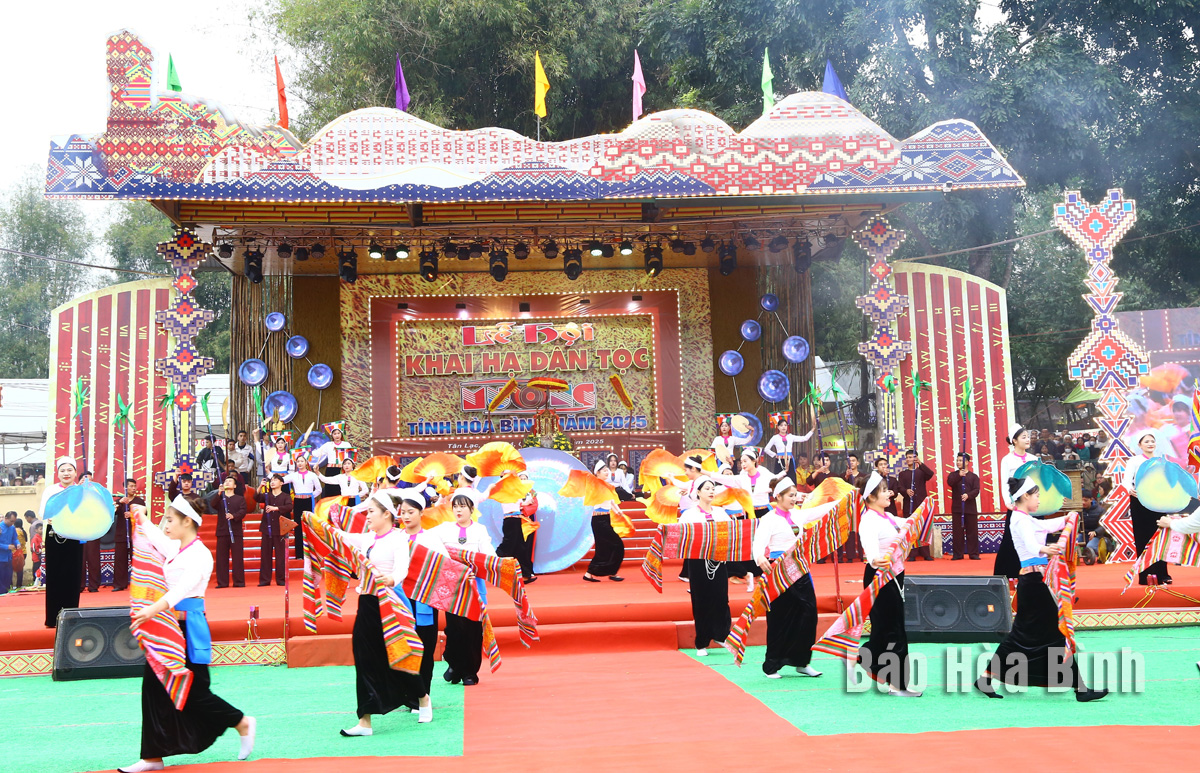



The annual Khai Ha (going down to the field) Festival of the Muong ethnic group in Hoa Binh province contributes to preserving and promoting the cultural values of the Muong people.
The Muong ethnic culture has long been the soul of Hoa Binh. From the resonating sounds of gongs during festivals in the four ancient Muong regions - Bi, Vang, Thang, and Dong - to the poetic call-and-response songs and customs around weddings and funerals, all are imbued with historical depth and a strong sense of community.
The Muong people not only live with their culture but also pass it down through generations as a sacred treasure, creating a distinct identity that is difficult to confuse with any other in Vietnam. Muong culture is a treasure, with a system of cultural heritage recognised at the national level, including the Muong bamboo calendar, the Khai Ha festival, Muong gong art, and Mo Muong. Currently, Mo Muong is under review for recognition by UNESCO as intangible cultural heritage of humanity.
The Muong people live harmoniously with nature, place great importance on relationships, and are rich in community spirit. Not only the Muong ethnic group but also the people of Hoa Binh province take pride in their rich local culture, which blends elements from the Northwestern region while maintaining its own distinct identity. These values have contributed to Hoa Binh's reputation, not just as an administrative unit but as a symbol of peace, humanity, and resilience in the face of adversity.
As a landmark, Hoa Binh is also a cultural symbol – the origin of the renowned "Hoa Binh Culture" in Southeast Asian archaeology, associated with the Neolithic period (around 10,000 years ago). The term "Hoa Binh Culture" was officially recognised by the archaeological community on January 30, 1932, following a proposal by Madeleine Colani at the Far-Eastern Prehistory Association Congress held in Hanoi. The "Hoa Binh Culture" dates back approximately 30,000 to 3,500 years ago. It holds significant importance in the Stone Age, not only in Vietnam but globally, as a valuable asset that has contributed important scientific data to further enriching the understanding of prehistory in Vietnam. In 2024, the archaeological sites of Trai Village Cave and Vanh Village’s Rock Shelter in Lac Son district were classified as the first special national relic sites in Hoa Binh province.
It can be affirmed that the cultural values of the Muong people and the modern "Hoa Binh Culture" represent a unique blend of indigenous Muong traditions with influences from the Northwestern region and the Red River Delta, thus creating a culturally rich and diverse space, while still preserving identity. In recent years, the province has implemented numerous effective policies to promote cultural development. A notable highlight is the allocation of resources to implement the project on preserving and promoting the cultural values of the Muong ethnic group and the Hoa Binh Culture for the 2023 - 2030 period.
However, in light of a major and groundbreaking policy by the Party and the State to merge the three provinces of Phu Tho, Vinh Phuc, and Hoa Binh into a single entity named Phu Tho province, concerns have been raised. In a report on voter feedback of the Standing Board of the provincial Vietnam Fatherland Front Committee on April 28, 2025, many voters expressed their concerns and anxieties, fearing that with the mergence, the cultural heritage of the "Hoa Binh Culture" and the ethnic identity of the Muong people may fade away or fail to receive proper attention and preservation.
These voices reflect a deep desire for all levels of administration to view the preservation and promotion of local culture as an inseparable part of the merger process. The merging of Phu Tho, Vinh Phuc, and Hoa Binh is not merely a matter of redrawing administrative boundaries, but also a complex undertaking that requires balancing efficient governance with the safeguarding of cultural identity.
Preserving the Muong culture and the distinctive "Hoa Binh Culture" amid this merger presents a significant challenge. However, if it is approached with the right focus and a clear, strategic vision, this challenge can become an opportunity. It offers the chance to promote the rich cultural heritage of Hoa Binh on a broader scale, in line with the evolving demands and spirit of a new era.
At the end of May, the Hoa Binh Provincial Ethnic Arts Troupe organized a series of performances for residents in Region 2 and Region 3 communes across the province. Bringing art to ethnic communities in remote, isolated, and especially disadvantaged areas has become a meaningful activity. These are not merely artistic performances but also journeys to disseminate cultural values, enrich spiritual life, and contribute to preserving the cultural identity of ethnic minorities.